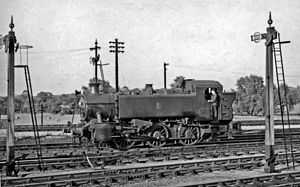GWR 1500 Class
| Great Western Railway 1500 Class | |
|---|---|
|
No. 1502 at Didcot 1957 | |
| Type and origin | |
| Power type | Steam |
| Builder | British Railways, Swindon Works |
| Order number | Lot 373 |
| Build date | 1949 |
| Total produced | 10 |
| Specifications | |
| Configuration | 0-6-0PT |
| Gauge | 4 ft 8 1⁄2 in (1,435 mm) |
| Driver diameter | 4 ft 7 1⁄2 in (1.410 m) |
| Minimum curve | 3 1⁄2 chains (230 ft; 70 m) |
| Wheelbase | 12 ft 10 in (3.91 m) |
| Locomotive weight | 58 long tons 4 cwt (130,400 lb or 59.1 t) |
| Boiler pressure | 200 lbf/in2 (1.4 MPa) |
| Cylinders | Two, outside |
| Cylinder size | 17.5 in × 24 in (444 mm × 610 mm) |
| Valve gear | Walschaerts |
| Valve type | Piston valves |
| Performance figures | |
| Tractive effort | 22,515 lbf (100.15 kN) |
| Career | |
| Operator(s) | British Railways, National Coal Board |
| Power class |
GWR: C BR: 4F |
| Number(s) | 1500–1509 |
| Axle load class | GWR: Red |
| Locale | Great Britain |
| Withdrawn |
BR: 1959–1963, NCB: 1970 |
The Great Western Railway (GWR) 1500 Class is a class of 0-6-0 pannier tank steam locomotive. Despite being a GWR design, all ten (nos 1500–1509) were built by the Western Region of British Railways in 1949.
Overview
Coming from a railway company with a well-developed standardisation policy, the 15xx was a strange design finale. Unlike almost all their forebears, they had outside cylinders, Walschaerts valve gear, and a very short wheelbase of 12 ft 10 in (3.91 m) to go round curves of 3.5 chains (230 ft; 70 m). Above footplate level they were very similar to the 9400 class, and shared the same Standard no.10 boiler. The surprises were below the (very small) footplate, where they resembled the USATC S100 Class that the GWR and other railways had used during the Second World War.
Although a sound design, the class had limited usefulness as they were route-restricted by their high weight and were unsuitable for fast running because of their short wheelbase. Largely confined to empty stock workings at London Paddington station, their lives were short; for example 1509 lasted barely ten years in BR service. Four of the class, 1506 to 1509, were based in Wales, Newport Pill, Ebbw Junction & Cardiff Canton, 1508[1] was withdrawn from that last shed. Like the 1600 and 9400 classes, their construction now appears to have been of doubtful value.
The onset of dieselisation and the decline in traffic on the railway network consigned the 1500s to scrap long before they were life-expired. However 1501 has enjoyed regular use at the Severn Valley Railway in preservation for far longer than its life in public ownership.
Preservation

1501 was one of the first of the class to be withdrawn in 1961, but was sold along with 1502 and 1509 to the National Coal Board for use at Coventry Colliery. The three locos were sent to Andrew Barclay Sons & Co., in Kilmarnock, Scotland for overhaul before delivery to the NCB. All three locomotives were purchased in 1970 by the Severn Valley Railway. Locomotives 1502 and 1509 were used as sources of spares for the restoration of 1501. The remains of 1502 and 1509 were cut up and scrapped at Cashmore's, Great Bridge in October 1970.
In 2006 No. 1501's boiler certificate expired and it was withdrawn from traffic. The locomotive has recently been completely overhauled,[2] and is now once again in revenue earning service. It has been repainted in British Railways lined black colour scheme with the early BR emblem on its tanks.
See also
- GWR 0-6-0PT – list of classes of GWR 0-6-0 pannier tank, including table of preserved locomotives
References
- ↑ Daniel, John. "'1500' tank class details". The Great Western Archive. Retrieved 2 December 2014.
- ↑ "Latest News". Severn Valley Railway.
- le Fleming, H.M. (April 1958). White, D.E., ed. Part 5: Six-coupled Tank Engines. The Locomotives of the Great Western Railway. RCTS.
- Whitehurst, Brian (1973). Great Western engines, names, numbers, types, classes: 1940 to preservation. Oxford: Oxford Publishing Company. pp. 18, 81, 101. ISBN 0-902888-21-8. OCLC 815661.
External links
| Wikimedia Commons has media related to GWR 1500 Class. |
- 1500 Class at the Great Western Archive (+ details, shed allocations, etc.)
| ||||||||||||||||||||||||||||||||||||||||||||||||||||||||||||||||||||||||||||||||||||||||||||||
